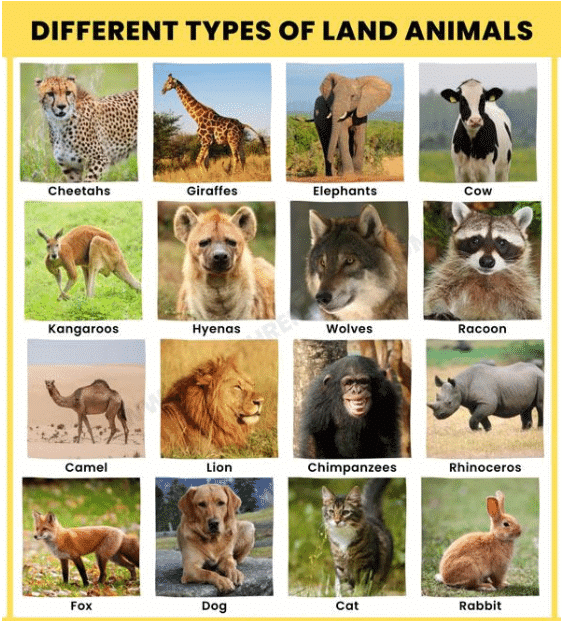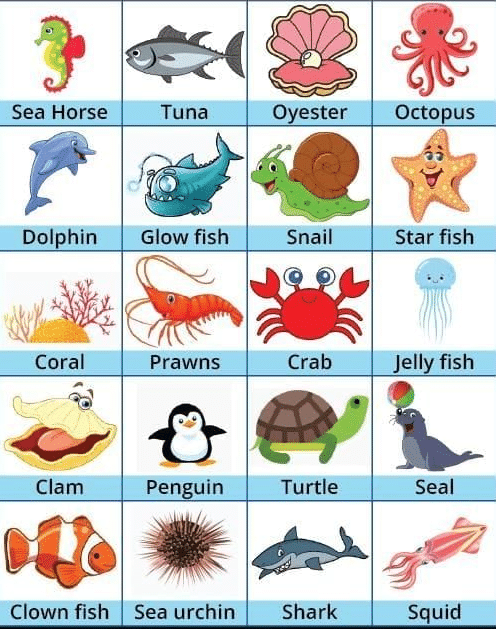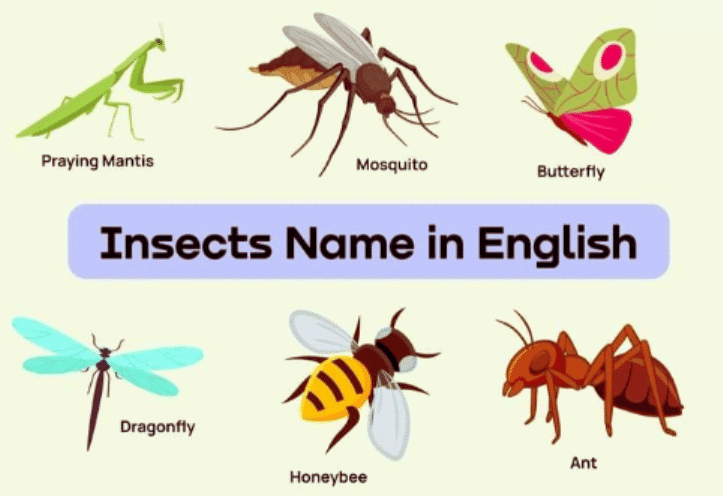Animals Everywhere Chapter Notes | Eureka Plus Class 5: Book Solutions, Notes & Worksheets PDF Download
Animals can be found all over the Earth, in places like forests, deserts, grasslands, mountains, rivers, and oceans. Based on their habitats, animals are mainly divided into two groups: Terrestrial Animals and Aquatic Animals.
Terrestrial Animals

Animals that live on land are known as terrestrial animals. They can be found in various environments such as open grasslands, hot deserts, wet rainforests, cold polar regions, and high mountains. Some terrestrial animals also live in close proximity to humans. Examples include ants, dogs, goats, deer, camels, tigers, tortoises, lizards, and peacocks.
Aquatic Animals

Animals that reside in water are called aquatic animals. They inhabit oceans, lakes, rivers, and ponds. Examples of aquatic animals include fish, starfish, corals, sea snakes, turtles, otters, whales, dolphins, and water birds.
Feeding Habits in Animals
All animals require food to survive, and they obtain it from their surroundings. The mouthparts of different animals are adapted to the type of food they eat. Animals are categorized based on their feeding habits into the following groups:
- Herbivores: Animals that eat only plants.
- Carnivores: Animals that feed on the flesh of other animals.
- Omnivores: Animals that eat both plants and the flesh of other animals.
- Scavengers: Animals that feed on the flesh of dead animals.
Let us explore the feeding habits of different groups of animals in more detail.
Insects

- Insects are small creatures. Many types of insects, like bees, moths, and butterflies, feed on nectar from flowers. They have a mouthpart that looks like a straw, which helps them suck up the nectar.
- Some insects, such as dragonflies and ladybird beetles, eat other insects. Others, like grasshoppers, munch on the leaves of plants. Mosquitoes are known to suck blood from animals. There are also insects that feed on decaying plant matter and even on animal dung.
Birds
- Different birds have different diets, and they use their beaks to eat. The size and shape of a bird's beak are determined by the type of food it consumes.
- Pigeon feeding on seeds
- Sunbird feeding on nectar
- Pelican feeding on fish
- Birds like doves and rock pigeons primarily eat seeds. Sunbirds and hummingbirds have specialized beaks that allow them to suck nectar from flowers. Pelicans and penguins are known for eating fish. Sparrows have a more varied diet, eating seeds, seedlings, insects, and fruits.
- Predatory birds like owls and eagles feed on the flesh of other animals. Eagles, for instance, have strong, curved beaks and powerful feet with sharp talons. Some rainforest eagles hunt small monkeys, while others catch fish. Vultures, on the other hand, are scavengers that eat the flesh of dead animals.
Feeding Habits of Animals
- Herbivores: Animals like rabbits, cows, goats, elephants, and tortoises are herbivores. They have broad, flat teeth that are ideal for chewing plants.
- Carnivores: Animals such as tigers and lions are carnivores. They possess physical features that help them catch and tear apart their prey. For instance, tigers have strong limbs with sharp claws and powerful jaws with sharp teeth. Other carnivores like sharks and killer whales have very sharp teeth and primarily feed on large fish. The blue whale, however, is a filter feeder that consumes tiny sea organisms like krill by filtering seawater through its mouth.
- Snakes: Snakes are also carnivores, but they do not chew their food. Instead, they swallow it whole. Smaller land snakes eat frogs, mice, rats, lizards, birds, and bird eggs, while larger snakes may eat larger land animals like deer and rabbits, as well as other snakes. Sea snakes primarily feed on fish.
- Omnivores: Bears and foxes are examples of omnivores, as they eat both plants and animals.
Movement in Animals
Animals move from place to place in search of food, water, and shelter. They also move to escape from animals that hunt them. There are different ways in which animals move.
Animals that Fly
- Most birds, bats, and insects can fly because they have wings. All insects have six legs, which help them walk.
- Birds are built for flying. They have two wings and two legs. The wings help them fly, while the legs help them walk and take off. Birds have hollow bones, which make their bodies light and help them fly.
- The body of a bird is covered with different kinds of feathers. The wings are covered with flight feathers, which help birds fly. The tail feathers help them control their flight.
- Some birds, like ostriches, kiwis, and emus, cannot fly because their wings are too small and weak compared to their large bodies.
 |
Download the notes
Chapter Notes: Animals Everywhere
|
Download as PDF |
Animals that Swim
- Animals that live in water can swim. Fish use their fins to swim, and their body shape also helps them move through the water.
- Whales, which live in the oceans, swim using their flippers.
- Penguins also have flippers. They spend almost half of their lives in the water. Their strong, wing-like flippers, streamlined bodies, and webbed feet make them excellent swimmers. Birds like ducks have webbed feet that help them swim too. Frogs swim using their webbed feet.
Animals that Walk, Run, Hop, or Slide
Animals that live on land usually have limbs, which they use to walk and run. Examples of such animals include mice, deer, dogs, and lizards. Some animals, like rabbits and kangaroos, use their strong back legs to hop.
Climbing and Jumping
- Animals like monkeys use their limbs to climb trees and jump from one tree to another. Leopards are also good at climbing trees.
Slithering and Swimming
- Snakes do not have limbs. They move by sliding their bodies, a movement called slithering. Most snakes are also good at swimming and climbing trees.
Animal Migration
- Animal migration is the long-distance journey of animals at a particular time of the year. Animals migrate in search of food and water or to avoid harsh weather conditions. Some animals migrate to find a favourable place for reproduction.
- Bar-headed geese live in the Himalayan mountains. In winter, they migrate to several regions in India to feed. When summer approaches, they fly back to the mountains.
- In summer, the water in the African grasslands dries up, prompting large animals like elephants, wildebeests, and zebras to travel long distances in search of water.
- Whales migrate to cold parts of the ocean for feeding and move to warmer waters to give birth to their young ones.
How do Animals Obtain Air?
Breathing with Lungs
- Animals like snails, snakes, lizards, turtles, crocodiles, birds, monkeys, lions, dolphins, whales, sea lions, and humans breathe using their lungs.
Breathing through Spiracles
- Insects breathe through small openings called spiracles. These spiracles lead to a network of tiny tubes inside the insect's body, which deliver air to every part of their system.
Breathing Underwater
- Fish and many other aquatic animals, such as corals, starfish, and jellyfish, obtain oxygen from water. Fish use their gills to extract oxygen from the water. As water passes over the gills, the blood flowing through them absorbs the oxygen, which is then distributed throughout the fish's body.
The Process of Breathing in Fish
- Fish take in water through their mouths, filling their gills with water. The blood in the gills absorbs the oxygen dissolved in the water. The water then flows out through a flap, and the oxygen is transported to the rest of the fish's body.
Frogs
- On Land: Frogs breathe air using their lungs.
- In Water: Frogs absorb oxygen through their moist skin.
Earthworms
- Earthworms take in oxygen through their moist skin. This is why they cannot survive in dry soil.
Glossary
- Aquatic Animals: Animals that live in water.
- Carnivores: Animals that eat the flesh of other animals.
- Herbivores: Animals that only eat plants.
- Migration: The regular long-distance movement of animals, usually in search of water and food, to escape harsh weather, or to find suitable places for reproduction.
- Omnivores: Animals that eat both plants and the flesh of other animals.
- Scavengers: Animals that feed on the flesh of dead animals.
- Spiracles: Tiny holes through which insects breathe.
- Terrestrial Animals: Animals that live on land.
FAQs on Animals Everywhere Chapter Notes - Eureka Plus Class 5: Book Solutions, Notes & Worksheets
| 1. What are the main differences between terrestrial and aquatic animals? |  |
| 2. How do animals adapt their feeding habits based on their environment? |  |
| 3. What are some common types of movement in animals? |  |
| 4. Why do animals migrate, and what are some examples? |  |
| 5. How do insects differ in their feeding habits compared to other animals? |  |




























